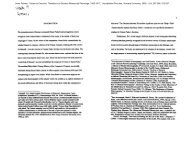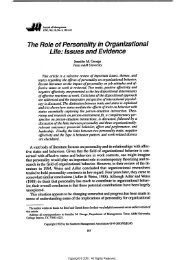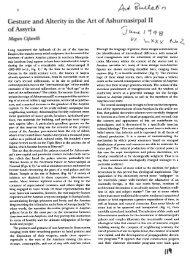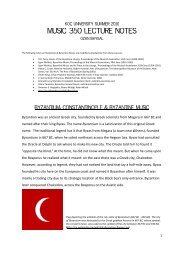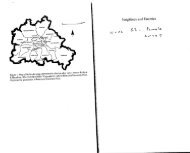The Hattian and Hittite Civilizations
The Hattian and Hittite Civilizations
The Hattian and Hittite Civilizations
Create successful ePaper yourself
Turn your PDF publications into a flip-book with our unique Google optimized e-Paper software.
examples (Fig.124-128). Another innovation seen on Assyrianized Late <strong>Hittite</strong> lions is that<br />
the W motif on the hindquarters, typical of Assyrian examples, has turned into N on the<br />
Zincirli <strong>and</strong> Sakçegözü lions (Fig. 124-128);later it will pass into Hellene art as a warped W<br />
(E. Akurgal, Anadolu Uygarlıkları, p. 187, 223 - 227). <strong>The</strong> two-fold division of the foreleg<br />
stylization that is seen on the Zincirli <strong>and</strong> Sakçegözü lions (Fig. 127, 128, 137) also comes<br />
from Assyrian art. This iconographic detail will take the form of two paralle1rods in Urartian<br />
works (Fig. 206-208). From there it passed into Scythian art (E. Akurgal, Anadolu<br />
Uygarlıkları, p. 189 Fig. 237).<br />
In later examples of this style the <strong>Hittite</strong> bird man of the Traditional Style has also<br />
changed. In the traditional style of Carchemish, the head of the bird man is an eagle's head,<br />
his ears are equine, the beak is closed <strong>and</strong> two pointed feathers adorn his head (Fig. 133).<br />
<strong>The</strong> bird men of Zincirli also show the same iconographic details (Fig. 121). In contrast, in<br />
the works of Sakçegözü that were executed around 730 BC (Fig. 134:), in addition to<br />
characteristics typical of the Traditional Style the beak is open, the tongue lol1sout, the lower<br />
beak has become the chin of a lion <strong>and</strong> the nape of the neck is decorated with a horse's<br />
mane. Thus is the bird man enriched at Sakçegözü, which had a high quality sculpture workshop.<br />
<strong>The</strong> horse's mane on the neck is a detail taken from Assyrian art. In the griffin relief<br />
from Ankara (Fig. 136), the palmette-shaped swelling under the eye is also an Assyrian<br />
influence. In contrast, the transformation of the bird man's lower beak into the jaw of alion,<br />
the tongue lolling out <strong>and</strong> furthermore the demarcation of the neck section with a fold of<br />
flesh are details taken from <strong>Hittite</strong> lions <strong>and</strong> with these the bird head gains in vitality.<br />
Another innovation is that the upper end of the feather decorating the head is not in a spiral<br />
shape but has taken the form of a bud. <strong>The</strong> Hellene vase painters would later copy, detail for<br />
detail, this interesting head of a bird man made by the Sakçegözü workshop. Urartian art was<br />
also inspired by the example of the Sakçegözü type (E. Akurgal, Ancient <strong>Civilizations</strong> <strong>and</strong><br />
Ruins afTurkey, p. 296 Fig. 135).<br />
Among the Carchemish works the King Araras group of orthostats (Fig. 157-165) are<br />
a!so Assyrianized examp!es (E. Akurgal, <strong>The</strong> Birth of Greek Art, pp. 120- 125). <strong>The</strong> style of<br />
King Araras' hair <strong>and</strong> his beIt are exactly like those in the Sanherib (704 - 681 BC) reliefs.<br />
<strong>The</strong> group of vertical pleats which we see on the back of the robes that he <strong>and</strong> his son wear<br />
is also found in works of New Babylonian art from the reign of Marduk-Apal-Iddin (721 - 710<br />
BC; see: Ibid., p. 70, PI. 19).<br />
For this reason we date the Araras orthostats to around 717 - 691 BC. From the st<strong>and</strong>point<br />
of the hairdo <strong>and</strong> the diagonal folds of the mantle, the monumenta! statue of a king that<br />
was found carefully buried in front of the city wall of Malatya is closely similar to the relief<br />
of a king among the Sakçegözü works. <strong>The</strong> relief is dated to around 730 BC. For these reasons<br />
one concludes that the Malatya statue was carved at the end of the 8th century BC<br />
(Akurgal, <strong>The</strong> Art ofthe <strong>Hittite</strong>s, P. 99, PI. 106 - 107).<br />
<strong>The</strong> Tell Halaf works (Fig. 150-156)cannot have been made earlier than the last quarter<br />
of the 8th century BC (E. Akurgal, "L'architecture et la sculpture de Tell Halafl', Florilegium<br />
214<br />
Malatya. Relief from the city wall of Aslantepe. <strong>The</strong> Sky God kills the dragon Illuyankas.<br />
Behind him is his son. 1050 - 850 BC. Museum of Anatolian <strong>Civilizations</strong>, Ankara.<br />
Early Traditiona1Style.<br />
King Sulumeli makes an offering to the Weather Gad. An orthostat black brought from<br />
Malatya. 1050 - 850 BC. Museum of Anatolian <strong>Civilizations</strong>, Ankara.<br />
Late <strong>Hittite</strong> Traditional Style i. <strong>The</strong>re are two complementary scenes in this reIiei On<br />
the Ieft is seen the Weather God in his chariot drawn by the sacred bulls Seri <strong>and</strong> Hurrİ.<br />
On the right he has descended from the chariot <strong>and</strong> is accepting the libation of King<br />
Sulumeli.



